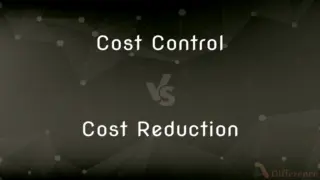Population Growth vs. Population Change — What's the Difference?
Edited by Tayyaba Rehman — By Fiza Rafique — Published on December 18, 2023
Population Growth refers to the increase in the number of individuals, while Population Change encompasses both increases and decreases, reflecting the net change.

Difference Between Population Growth and Population Change
Table of Contents
ADVERTISEMENT
Key Differences
Population Growth signifies the rise in the total number of individuals within a specific region over time. Population Change, conversely, is a broader term that includes not only growth but also the decline in numbers, indicating the overall shift.
In demographic studies, Population Growth is often used to emphasize positive increments in numbers, mainly due to births and migration. Population Change, however, considers all factors causing fluctuations, such as births, deaths, in-migration, and out-migration.
It's crucial to understand that Population Growth is inherently a subset of Population Change, focusing solely on the ascending trends. On the other hand, Population Change is an umbrella term, reflecting the entire spectrum of population dynamics, both upward and downward.
While discussing global concerns like resources and sustainability, Population Growth often draws attention due to the strain it places on these resources. In contrast, Population Change can indicate regions facing both overpopulation challenges or the issues of declining populations and aging.
Examining Population Growth helps in identifying regions that might face overcrowding, leading to various socio-economic implications. Population Change, however, can provide insights into regions that may be shrinking, which can have significant consequences for the workforce, economy, and infrastructure.
ADVERTISEMENT
Comparison Chart
Definition
Increase in number of individuals.
Net change, including both increases and decreases.
Inherently
Positive
Neutral, can be positive or negative.
Focus
Births, in-migration leading to rise.
Births, deaths, in-migration, out-migration causing shifts.
Implications
Overcrowding, resource strain.
Overpopulation or declining population challenges.
Relation
Subset of Population Change.
Broader term encompassing all dynamics.
Compare with Definitions
Population Growth
Population Growth can be influenced by positive net migration.
Many professionals moved to the tech hub, leading to its Population Growth.
Population Change
Population Change considers both growth and decline factors.
Due to aging residents and few births, the village faced negative Population Change.
Population Growth
Population Growth represents the positive side of population dynamics.
Developing countries often have higher rates of Population Growth.
Population Change
Population Change encapsulates the total shift in inhabitants.
The Population Change statistics revealed the migration trends of the state.
Population Growth
Population Growth is the increase in inhabitants in a region.
The city witnessed rapid Population Growth due to the new industries.
Population Change
Population Change gives a holistic view of population dynamics.
Studying Population Change helps in understanding both urbanization and depopulation patterns.
Population Growth
Population Growth results from births exceeding deaths.
Improved healthcare led to a notable Population Growth in the country.
Population Change
Population Change can be due to economic, social, or natural factors.
The recession played a significant role in the city's Population Change.
Population Growth
Population Growth often implies expanding demands and challenges.
The local government had to cater to the Population Growth by improving infrastructure.
Population Change
Population Change reflects the net variation in population numbers.
The town experienced a Population Change after many residents moved away.
Common Curiosities
Is Population Growth always positive?
Yes, Population Growth indicates a rise in numbers.
What is Population Growth?
It refers to the increase in the number of individuals in a region.
How does Population Change differ from Growth?
Population Change reflects both increases and decreases, showing net change.
Can a region have negative Population Growth?
Technically no, negative growth would be a decline, which falls under Population Change.
Can Population Change indicate a decline?
Absolutely, it can show both growth and decline in population.
What factors contribute to Population Growth?
Births exceeding deaths and positive net migration lead to Population Growth.
Why study Population Change?
It provides insights into regional dynamics, including growth, decline, and migration trends.
What factors are considered in Population Change?
Births, deaths, in-migration, and out-migration are all factors.
Is Population Growth a concern?
It can be, especially if it leads to resource strain or overcrowding.
How does Population Change affect economies?
Significant Population Change can influence workforce availability, consumer markets, and infrastructure demands.
Does Population Growth always signify prosperity?
Not necessarily, unchecked Population Growth can pose challenges like resource shortages.
Is Population Growth a subset of Population Change?
Yes, Population Growth focuses on the increase, while Population Change includes all dynamics.
How does migration influence Population Change?
Migration, both in and out, plays a significant role in the overall Population Change.
Which term is broader: Population Growth or Population Change?
Population Change is broader, encompassing all changes in population.
How do aging populations influence Population Change?
Aging populations can lead to a decline in population, affecting the overall Population Change.
Share Your Discovery

Previous Comparison
Cost Control vs. Cost Reduction
Next Comparison
Audit Plan vs. Audit ProgrammeAuthor Spotlight
Written by
Fiza RafiqueFiza Rafique is a skilled content writer at AskDifference.com, where she meticulously refines and enhances written pieces. Drawing from her vast editorial expertise, Fiza ensures clarity, accuracy, and precision in every article. Passionate about language, she continually seeks to elevate the quality of content for readers worldwide.
Edited by
Tayyaba RehmanTayyaba Rehman is a distinguished writer, currently serving as a primary contributor to askdifference.com. As a researcher in semantics and etymology, Tayyaba's passion for the complexity of languages and their distinctions has found a perfect home on the platform. Tayyaba delves into the intricacies of language, distinguishing between commonly confused words and phrases, thereby providing clarity for readers worldwide.











































